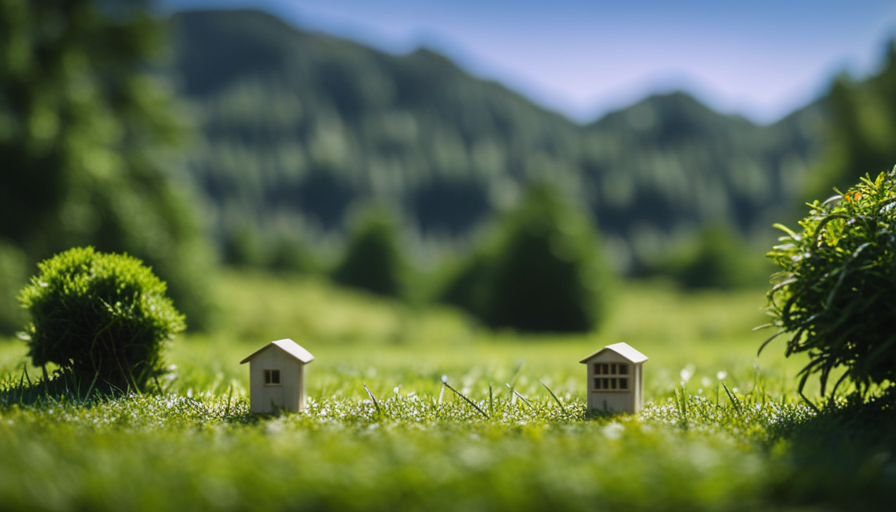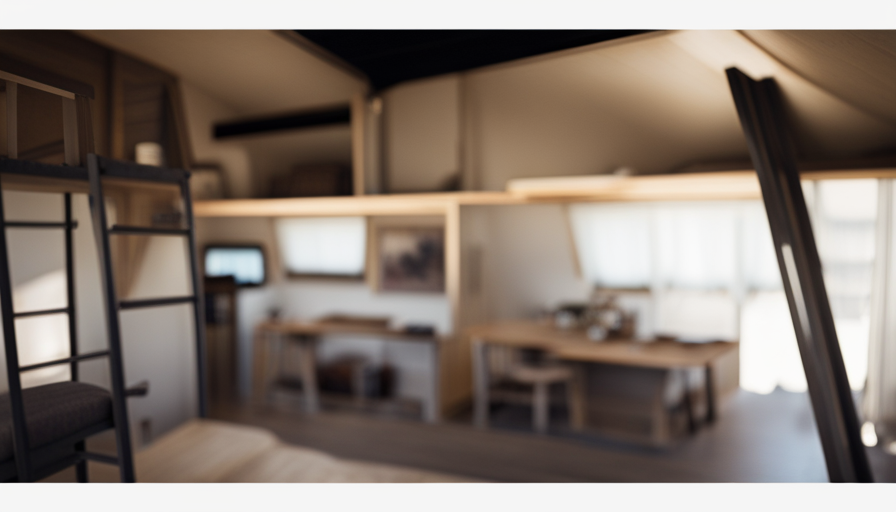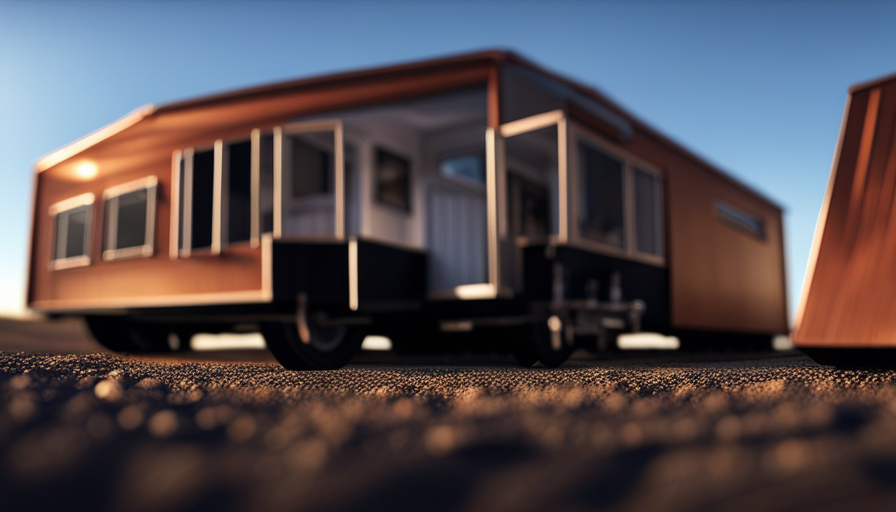It’s so ironic how in a culture that typically values bigger as better, the trend of small homes has emerged as a refreshing change. Who would have thought that downsizing could bring so much joy and freedom?
But here’s the thing – while the tiny house may be small, the decision about how big of a lot you need to accommodate it is anything but. It requires careful consideration and planning to ensure that your tiny dream home has the space it needs to thrive.
In this article, we will dive deep into the factors that determine the size of the lot for a tiny house. From your lifestyle and needs to local zoning regulations, accessibility, and even future expansion possibilities, we will leave no stone unturned.
So join me on this journey as we navigate the world of tiny house living and find out just how big of a lot is the perfect fit for your tiny home.
Key Takeaways
- Factors such as lifestyle, needs, zoning regulations, accessibility, and future expansion possibilities determine the lot size for a tiny house.
- Research local zoning and building regulations for permits and compliance with minimum lot size requirements.
- Assess the accessibility and utilities of the lot, including road access, availability of electricity, water, and sewage systems.
- Consider the cost and affordability of the lot, including market value, property taxes, utilities, and maintenance costs.
Consider Your Lifestyle and Needs
When it comes to deciding on the size of a lot for your tiny house, it’s important to consider your lifestyle and what you truly need.
One of the first things to think about is your budget considerations. While tiny houses are generally more affordable than traditional homes, the cost of land can vary significantly depending on location and size. Take into account the cost of the lot, as well as any additional expenses such as utilities and permits.
Designing for sustainability is another crucial aspect to consider. Look for a lot that allows for energy-efficient features like solar panels or rainwater collection systems. Additionally, consider the orientation of the lot to maximize natural light and ventilation. Think about the surrounding environment and whether it aligns with your eco-friendly goals.
Finally, keep in mind the space requirements for your tiny house. Determine how many rooms and amenities you need, and ensure that the lot is large enough to accommodate them comfortably. By carefully considering your lifestyle, budget, and sustainability goals, you can find the perfect lot for your tiny house that meets all your needs.
Determine the Space Requirements for Your Tiny House
To determine the space needed for your cozy abode, consider the dimensions of the plot you have in mind. Lifestyle considerations play a crucial role in determining the size of your tiny house. Are you a minimalist who thrives in a compact space or do you prefer a bit more room to move around? Take into account your daily activities and hobbies that require extra space. A helpful way to visualize the space requirements is by creating a table that outlines the different areas and their corresponding dimensions. For example:
| Area | Dimensions (in feet) |
|---|---|
| Living Room | 10×10 |
| Kitchen | 8×6 |
| Bedroom | 8×8 |
By mapping out the dimensions of each area, you can better understand the total space needed for your tiny house. Additionally, zoning restrictions should also be considered when determining the size of your lot. Research local zoning and building regulations to ensure compliance with any minimum lot size requirements. This will help you find a lot that is suitable for your tiny house and avoid any potential legal issues.
Research Local Zoning and Building Regulations
Before you start planning your dream home, it’s important to research the local zoning and building regulations in your desired area to ensure you can create a space that meets both your needs and the legal requirements.
Did you know that 78% of cities have specific regulations for tiny houses? These regulations vary greatly from one location to another, so it’s crucial to familiarize yourself with the local permits and building codes that apply to your area.
Local permits are necessary to ensure that your tiny house meets safety standards and is in compliance with the law. These permits typically cover aspects such as electrical and plumbing systems, as well as structural requirements. Building codes, on the other hand, dictate the minimum standards for construction and ensure that your tiny house is built to withstand the elements and provide a safe living environment.
By researching local zoning and building regulations, you can avoid potential legal issues and setbacks during the construction process. This step will help you understand the specific requirements for your tiny house, such as size limitations, setback requirements, and whether or not you can place your tiny house on a permanent foundation.
Now that you have a good understanding of the local permits and building codes, it’s time to assess the accessibility and utilities of the lot.
Assess the Accessibility and Utilities of the Lot
Now that I’m ready to make my dream of owning a tiny house a reality, I need to take a moment to consider how easily I can access the perfect location and what utilities are available to support my vision.
Assessing the accessibility of the lot is crucial in determining if it is suitable for a tiny house. I will need to evaluate factors such as road access, driveway width, and any potential obstacles that may hinder the delivery and installation of my tiny house.
Additionally, I need to evaluate utility options to ensure that the lot can support my needs. This includes determining if there is access to electricity, water, and sewage systems. If these utilities are not readily available, I will need to explore alternative options such as solar panels, rainwater collection systems, and composting toilets.
By thoroughly assessing the accessibility and utility options of the lot, I can ensure that it is the perfect fit for my tiny house. Once these aspects are considered, I can then move on to evaluating the surrounding environment and amenities, which will further enhance my tiny house living experience.
Evaluate the Surrounding Environment and Amenities
Take a moment to soak in the natural beauty and vibrant atmosphere that surrounds your potential new home, as you evaluate the amenities and environment that will enhance your tiny house living experience.
When evaluating the natural surroundings of the lot, consider the landscape and vegetation. Are there trees and green spaces that provide a sense of tranquility and privacy? Is the lot located near a body of water, such as a lake or river, which can offer recreational opportunities?
Assessing the proximity to amenities is equally important. Is the lot located within a short distance of grocery stores, restaurants, and other essential services? Are there community spaces, parks, or recreational facilities nearby that can enrich your daily life?
Evaluating these factors will help you determine the convenience and accessibility of the lot. As you transition into the subsequent section about determining the cost and affordability of the lot, it’s important to consider how the amenities and environment contribute to its overall value and desirability.
Determine the Cost and Affordability of the Lot
Consider the financial implications and feasibility of the plot by assessing its price and affordability, ensuring that it doesn’t stretch your budget too thin like a rubber band on a hot summer day. When determining the cost and affordability of the lot for your tiny house, it’s crucial to conduct a comprehensive cost analysis.
Begin by researching the average prices of similar lots in the area to get an idea of the market value. Take into account any additional expenses such as property taxes, utilities, and potential maintenance costs. Calculate your budget and evaluate whether purchasing the lot fits within your financial means.
Financial considerations are essential to ensure that you can comfortably afford the lot without compromising other aspects of your life. Take a close look at your income, savings, and any potential financing options available to you. It’s crucial to strike a balance between affordability and quality. Remember, the goal is to find a lot that not only meets your needs but also aligns with your budget.
Once you have determined the cost and affordability of the lot, you can consider future expansion or additional structures. This will allow you to plan ahead and ensure that the lot can accommodate any future changes or additions to your tiny house. By carefully considering the financial aspects of the lot, you can make an informed decision that will set you up for success in the long run.
Consider Future Expansion or Additional Structures
Planning for the future and envisioning the growth of your dream space can bring a sense of excitement and anticipation to your journey of finding the perfect place for your cozy haven. When considering the size of the lot for your tiny house, it’s important to think about future expansion or the addition of other structures. Here are some key points to keep in mind:
-
Flexibility: Choose a lot that allows for potential expansion in the future. You may want to add a workshop, a guest house, or even a garden shed. Having the space to accommodate these additional structures will give you the freedom to adapt and grow as your needs change.
-
Zoning regulations: Before making a decision, research the zoning regulations in your area. Some areas may have restrictions on the size or number of structures allowed on a lot. Understanding these regulations will help ensure that you can legally expand your tiny house in the future.
-
Accessibility: Consider the accessibility of the lot for future construction projects. Will there be enough space for construction vehicles and equipment? Will there be easy access to utilities and services? Thinking ahead will save you time and money when it comes to future expansion.
-
Aesthetics: Think about how the additional structures will fit into the overall aesthetic of your tiny house. Will they enhance the beauty and functionality of your space, or will they detract from it? Choose a lot that allows for cohesive design and harmonious integration of future structures.
-
Budget: Finally, consider the financial implications of future expansion. Will you have the resources to build and maintain additional structures? Make sure to factor in the cost of materials, labor, and ongoing maintenance when determining the size of your lot.
As you plan for the future and consider the potential growth of your tiny house, it’s important to account for outdoor living space and landscaping.
Account for Outdoor Living Space and Landscaping
When considering the size of a lot for a tiny house, it is important to account for not only the structure itself but also the outdoor living space and landscaping. This is an often overlooked aspect that can greatly enhance the overall living experience in a tiny house.
Outdoor living design plays a crucial role in maximizing the usable space of a small lot. By incorporating elements such as a patio, deck, or even a small garden, you can create additional areas for relaxation, dining, or entertaining guests. This not only expands the living area but also adds aesthetic appeal to the overall property.
Landscaping ideas can further enhance the outdoor space around a tiny house. From creating a lush garden with colorful flowers and plants to incorporating features like a fire pit or a small pond, landscaping allows you to personalize your outdoor area and create a tranquil oasis.
To illustrate the importance of outdoor living design and landscaping, consider the following table:
| Outdoor Living Design | Landscaping Ideas | Benefits |
|---|---|---|
| Patio or Deck | Lush Garden | Expands living area |
| Outdoor Dining Area | Colorful Flowers | Adds aesthetic appeal |
| Fire Pit | Small Pond | Creates a tranquil oasis |
By carefully planning and incorporating these elements into the design of your tiny house and lot, you can create a harmonious and inviting outdoor space. This will not only enhance your daily living but also provide a beautiful backdrop for your tiny house.
Now, let’s move on to the next section and explore how consulting with experts or tiny house communities can provide valuable insights and guidance in determining the ideal lot size for your tiny house.
Consult with Experts or Tiny House Communities
Seeking advice from professionals or engaging with tiny house communities can provide valuable insights and guidance when determining the ideal size for your outdoor living space and landscaping. When it comes to consultation benefits, experts in the field can offer expertise and knowledge that can help you make informed decisions. They can assess your specific needs and preferences, taking into account factors such as climate, available space, and intended use of the outdoor area.
Additionally, they can provide recommendations on the best materials, plants, and design elements to incorporate into your landscaping, ensuring both functionality and aesthetics.
Community considerations are also important when it comes to designing your outdoor space. Engaging with tiny house communities allows you to tap into a network of like-minded individuals who have already gone through the process of designing their own outdoor living areas. They can share their experiences, provide valuable tips, and offer practical advice based on their own successes and challenges.
Additionally, being part of a community can provide opportunities for collaboration and shared resources, such as tool sharing or joint landscaping projects.
By consulting with experts or engaging with tiny house communities, you can gather invaluable information and insights to help you make an informed decision based on your preferences and budget. Transitioning into the subsequent section, it is important to consider all these factors in order to make the best choices for your outdoor living space and landscaping.
Make an Informed Decision Based on Your Preferences and Budget
Based on your preferences and budget, it’s crucial to gather information and insights from experts or tiny house communities to make an informed decision on the size and design of your outdoor living space and landscaping.
Did you know that according to a survey, 85% of tiny house owners prioritize functionality over size when it comes to their outdoor areas? This highlights the importance of carefully considering your needs and desires before making any decisions.
To assist you in this process, here are four key factors to consider:
-
Tiny House Design: Determine the layout and features you want for your tiny house. This will help you understand the space requirements and how it will impact your outdoor living area. Consider whether you want a covered patio, a garden space, or room for outdoor activities.
-
Financing Options: Research different financing options available for tiny house construction and land purchase. Understanding your financial capabilities will help you determine the size of the lot you can afford and the landscaping options you can explore.
-
Zoning Restrictions: Check local zoning regulations to ensure you comply with any restrictions on lot size or outdoor structures. This will avoid any legal issues in the future and ensure you can enjoy your tiny house without any complications.
-
Maintenance and Upkeep: Consider the level of maintenance and upkeep required for different outdoor elements. This will help you decide on the size of the lot and the landscaping features that align with your lifestyle and available resources.
By considering these factors and gathering information from experts or tiny house communities, you can make an informed decision on the size and design of your outdoor living space and landscaping. Remember, your preferences and budget are the driving forces behind this decision, so take the time to analyze your options and choose wisely.
Frequently Asked Questions
What are some things to consider when choosing a lot for a tiny house based on my lifestyle and needs?
When choosing a lot for a tiny house based on my lifestyle and needs, there are several things to consider.
Firstly, I need to determine my space requirements, ensuring that the lot provides enough room for the tiny house and any additional outdoor living areas I desire.
Secondly, I must research and understand the zoning regulations in the area to ensure that my tiny house is allowed and compliant.
By carefully considering these factors, I can find the perfect lot for my tiny house that meets my needs and adheres to local regulations.
How can I determine the space requirements for my tiny house before choosing a lot?
To determine the space requirements for my tiny house before choosing a lot, I need to consider my lifestyle and needs. This involves evaluating the number of occupants, desired amenities, and desired living areas.
Additionally, I should consider any future plans or potential changes in my living situation. By carefully assessing these factors, I can determine the appropriate space requirements for my tiny house, which will then inform my lot selection process.
What should I research regarding local zoning and building regulations before purchasing a lot for my tiny house?
When researching local zoning and building regulations before purchasing a lot for my tiny house, it’s crucial to be knowledgeable about the specific requirements. Researching these regulations helps in determining if the lot is suitable for my tiny house.
It’s important to consider space requirements and lifestyle considerations while choosing a lot. By conducting thorough research, I can ensure that my tiny house will comply with local zoning and building regulations, making the purchasing process smoother.
How can I assess the accessibility and availability of utilities on a potential lot for my tiny house?
Assessing utilities and lot accessibility is crucial when considering a potential lot for my tiny house. To ensure a smooth living experience, it’s important to evaluate the availability of essential services such as water, electricity, and sewage connections.
Researching local codes and regulations will provide insight into any restrictions or requirements for utility installations. Additionally, physically inspecting the lot can help determine if it is easily accessible for utility hookups and if there are any existing infrastructure limitations.
What factors should I evaluate regarding the surrounding environment and amenities when selecting a lot for a tiny house?
When selecting a lot for my tiny house, I evaluate the surrounding environment and amenities to ensure a comfortable and convenient living experience.
I consider factors such as the neighborhood safety, proximity to essential facilities like grocery stores and hospitals, and the availability of recreational spaces.
The surrounding environment should be conducive to my lifestyle and preferences, providing a pleasant atmosphere and access to nature.
Additionally, having nearby amenities adds convenience and enhances the overall quality of living.
Conclusion
In conclusion, after carefully considering my lifestyle, needs, and the various factors involved, I have come to realize that determining the size of the lot for my tiny house is no small feat.
It requires thorough research, assessment, and consultation with experts or tiny house communities.
As the saying goes, "Don’t bite off more than you can chew," choosing the right lot size is crucial for optimal living and future expansion.
With a well-informed decision that aligns with my preferences and budget, I can create a cozy and sustainable haven in the perfect little plot of land.
Hi, I’m Emma. I’m the Editor in Chief of Tiny House 43, a blog all about tiny houses. While tree houses are often associated with childhood, they can be the perfect adult retreat. They offer a cozy space to relax and unwind, surrounded by nature. And since they’re typically built on stilts or raised platforms, they offer stunning views that traditional homes simply can’t match. If you’re looking for a unique and romantic getaway, a tree house tiny house might just be the perfect option.










